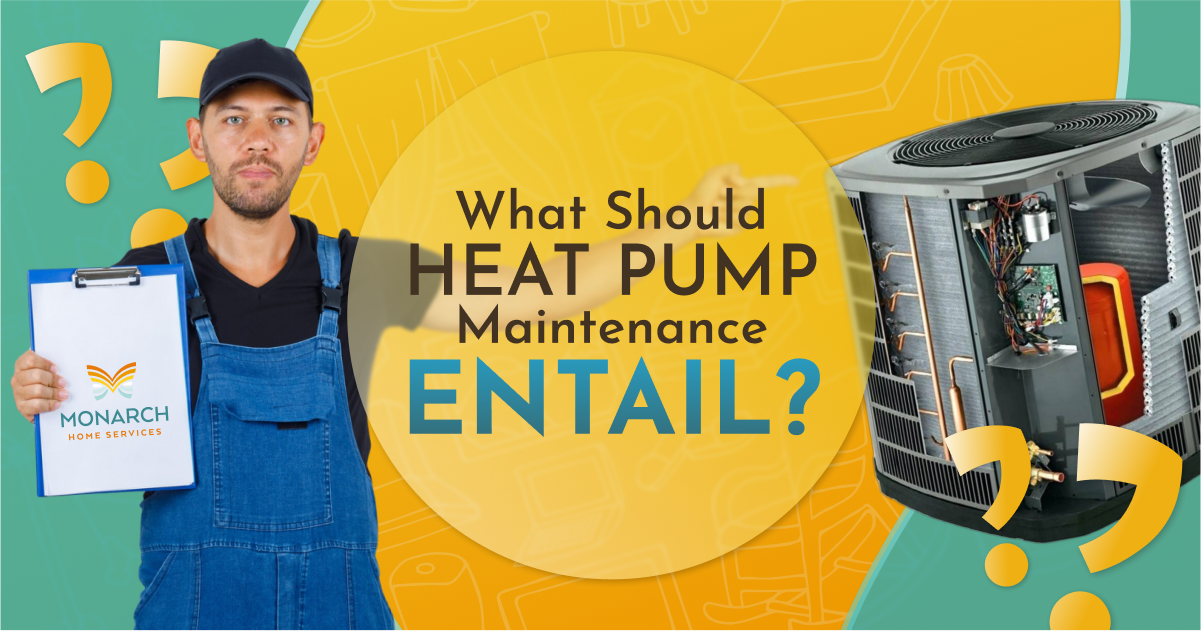Heat pump maintenance entails various tasks that you can DIY and that a professional should take care of twice a year. Unlike other HVAC systems, heat pumps require more frequent service because they run every season, as they can provide heating and cooling. Your heat pump should be maintained by a professional in the spring and fall. We’ll detail how you should care for the system and what our technicians at Monarch Home Services do during a service call.
DIY Heat Pump Maintenance Steps
We don’t recommend waiting for a professional to perform preventative maintenance. While it’s not advised to disassemble your heat pump or perform any tasks you’re unfamiliar with, there are simpler things you can do that are important to the health of the system:
- Check the Filter Every Month: How often you change the filter depends on the type and what the manufacturer recommends. Replace the filter whenever it looks dirty. You should check it every month. If you have an air-source heat pump, a clogged filter will restrict airflow, reduce performance, and stress the system.
- Clean the Outside Unit: Leaves, grass clippings, and debris can collect on the outside unit. These can disrupt airflow and cause the unit to overheat. Brush off any debris from time to time and remember to check for buildup to avoid any issues.
- Clean the Outside Coil: Follow the manufacturer’s instructions for cleaning the coil, if possible. Some units have coils that are more accessible and easier to clean. Unless the task involves taking the unit apart or tools you’re unfamiliar with, you may be able to clean off the coil.
- Keep the Registers Clear: Furniture, drapes, rugs, and other items can block airflow, so keep them away from the registers. Move them if a vent seems to be blocked. The investment in a heat pump is worth it when the system can run smoothly and efficiently.
- Set the Thermostat to a Consistent Temperature: Constantly changing the settings reduces efficiency. Rather than turning the thermostat down at night, set it to a temperature you are most comfortable with most of the time. After all, you’ve chosen a heat pump to save on heating costs!
Keeping up with DIY heat pump maintenance, especially changing the air filter as recommended, can prevent mechanical damage and costly repairs. It can also make the professional maintenance process easier.
Professional Heat Pump Maintenance Steps
During a biannual heat pump checkup, a trained technician should perform the following tasks:
- Check for Wear, Dirt, or Leakage: The blower motor, fan bearings, evaporator coil, and other major components are checked for dirt and wear. Repairs can be made if needed. The technician will also check air ducts for leaks and seal them.
- Measure the Refrigerant Level: The refrigerant must be filled to the unit’s precise specifications for it to work properly. If they find a low level, the contractor can check for leaks, repair them, and recharge the system.
- Check Electrical Wiring: All system wiring is inspected for wear or damage (and replaced if necessary), while any loose connections are tightened to ensure your heat pump runs smoothly.
- Inspect Disconnect Switches: The switches are inspected and tested. Ensuring these are working as designed helps prevent electrical hazards with your heat pump.
- Clear the Condensate Drain: If there are any obstructions in the drain line, they are cleared, while any cracks or leaks are repaired. The drain line is flushed to ensure no drainage issues persist.
- Test System Controls: During heat pump maintenance, the technician tests the controls to evaluate how your heat pump starts up and shuts down. Any delays, noises, or vibrations are investigated so the underlying issue can be fixed.
- Clean the Condenser: A more thorough cleaning of the condenser unit includes the coil and fan. The technician also checks for excess vibration and uses professional equipment to test the amp draw.
- Component Checks: Belts, pulleys, and other parts are checked for alignment issues while blower wheels and motors are evaluated. The refrigerant metering device is inspected and the defrost assembly and defrost timer are checked. Mountings and fan bearings are also inspected.
- Lubricate Moving Parts: An important step in the heat pump maintenance process, this entails lubricating the motor and other mechanical components. It reduces the risk of friction-related wear and can improve your heat pump’s efficiency.
- Test the Thermostat: The technician verifies whether temperature readings are correct and that thermostat sensors are working. If the unit doesn’t reflect the current conditions in your home, they will determine why and address the reason.
Schedule Heat Pump Maintenance with Monarch Home Services
Homeowners in the San Joaquin Valley who have heat pumps can count on our experienced HVAC technicians to provide thorough heat pump maintenance. They are familiar with many brands, units, and parts. We also offer a Maintenance Agreement to reduce the costs of heating service and ensure your system gets the care it needs. It includes two annual inspections and discounts on repairs. To schedule your next maintenance visit, call (661) 215-6737 today.


